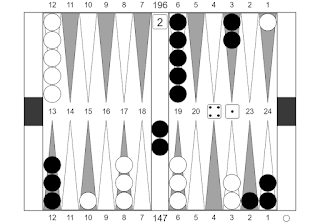How should White play 65 here? Whatever you decide to do here, it is important to keep your 21 point anchor. It is your insurance against disaster – here that means not being blitzed and closed out. When this happened over the board, White was confused about what to do, so he figured that he might as well put his opponent on the bar and played 6/1* 13/7: This may put your opponent on the bar, but it gives them a direct shot from the bar at the blot on your 1 point as well as indirect shots. The other problem with this play is that it leaves 3 blots around the board. Even if you are missed, you may not be able to tidy them all up. This play is too big. It would be nice to make a useful point if you are missed, so you consider 13/8 13/7: This does duplicate Blacks 6’s to hit both checkers, but things can go very wrong for you here, just because you are still leaving 2 blots. The more blots you get sent back, the more checkers you will have back. The more checkers you have back,








